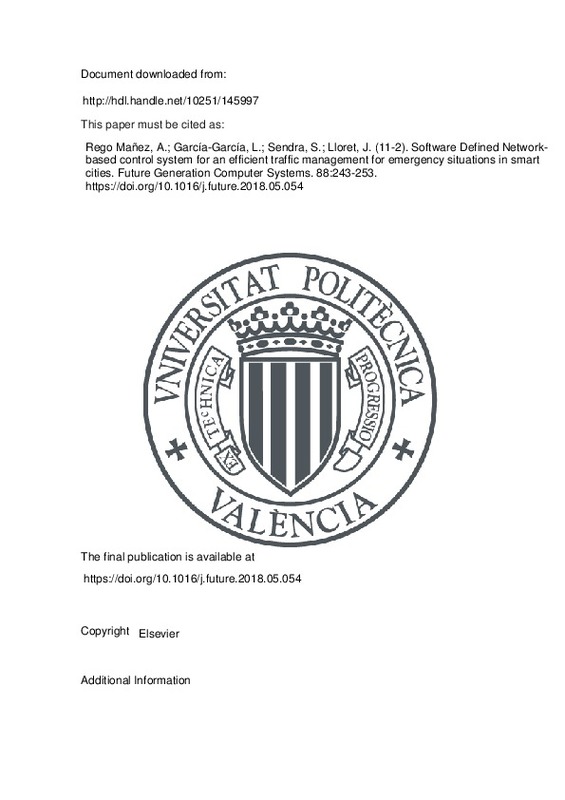JavaScript is disabled for your browser. Some features of this site may not work without it.
Buscar en RiuNet
Listar
Mi cuenta
Estadísticas
Ayuda RiuNet
Admin. UPV
Software Defined Network-based control system for an efficient traffic management for emergency situations in smart cities
Mostrar el registro sencillo del ítem
Ficheros en el ítem
| dc.contributor.author | REGO MAÑEZ, ALBERT
|
es_ES |
| dc.contributor.author | García-García, Laura
|
es_ES |
| dc.contributor.author | Sendra, Sandra
|
es_ES |
| dc.contributor.author | Lloret, Jaime
|
es_ES |
| dc.date.accessioned | 2020-06-11T03:33:44Z | |
| dc.date.available | 2020-06-11T03:33:44Z | |
| dc.date.issued | 2018-11 | es_ES |
| dc.identifier.issn | 0167-739X | es_ES |
| dc.identifier.uri | http://hdl.handle.net/10251/145997 | |
| dc.description.abstract | [EN] Smart cities provide new applications based on Internet of Things (loT) technology. Moreover, Software Defined Networks (SDNs) offer the possibility of controlling the network based on applications requirements. One of the main problems that arise when an emergency happens is minimizing the delay time in emergency resource forwarding so as to reduce both human and material damages. In this paper, a new control system based on the integration of SDN and loT in smart city environments is proposed. This control system actuates when an emergency happens and modifies dynamically the routes of normal and emergency urban traffic in order to reduce the time that the emergency resources need to get to the emergency area. The architecture is based on a set of loT networks composed by traffic lights, traffic cameras and an algorithm. The algorithm controls the request of resources and the modification of routes in order to ease the movement of emergency service units. Afterwards, the proposal is tested by emulating a Smart City as a SDN-utilizing Mininet. The experiments show that the delay of the emergency traffic improves in a 33% when the algorithm is running. Moreover, the energy consumed by the loT nodes is modeled and the obtained results display that it increases linearly with the number of nodes, therefore, the proposal is scalable. (C) 2018 Elsevier B.V. All rights reserved. | es_ES |
| dc.description.sponsorship | This work has been partially supported by the " Ministerio de Educacion, Cultura y Deporte", through the "Ayudas para contratos predoctorales de Formacion del Profesorado Universitario FPU (Convocatoria 2015)". Grant number FPU15/06837, by the "Ministerio de Economia y Competitividad", through the "Convocatoria 2014. Proyectos I+D - P rograma Estatal de Investigacion Cientifica y Tecnica de Excelencia" in the "Subprograma Estatal de Generacion de Conocimiento", project TIN 2014-57991- C 3 - 1 - P and through the "Convocatoria 2016 - Proyectos I+D+I - P rograma Estatal De Investigacion, Desarrollo e Innovacion Orientada a los retos de la sociedad" (Project TEC 2016 - 76795 - C 6 - 4 - R). This work has also been partially supported by the "Ministerio de Economia y Competitividad" in the "Programa Estatal de Fomento de la Investigacion Cientifica y Tecnica de Excelencia, Subprograma Estatal de Generacion de Conocimiento" within the project under Grant TIN2017-84802-C2-1-P. | es_ES |
| dc.language | Inglés | es_ES |
| dc.publisher | Elsevier | es_ES |
| dc.relation.ispartof | Future Generation Computer Systems | es_ES |
| dc.rights | Reserva de todos los derechos | es_ES |
| dc.subject | Software Defined Networks (SDN) | es_ES |
| dc.subject | Internet of Things (loT) | es_ES |
| dc.subject | Smart city | es_ES |
| dc.subject | Emergency situations | es_ES |
| dc.subject | Quick evacuation | es_ES |
| dc.subject | Traffic | es_ES |
| dc.subject | Energy consumption | es_ES |
| dc.subject | Cloud | es_ES |
| dc.subject | Network performance | es_ES |
| dc.subject | Jitter | es_ES |
| dc.subject | Delay | es_ES |
| dc.subject.classification | INGENIERIA TELEMATICA | es_ES |
| dc.title | Software Defined Network-based control system for an efficient traffic management for emergency situations in smart cities | es_ES |
| dc.type | Artículo | es_ES |
| dc.identifier.doi | 10.1016/j.future.2018.05.054 | es_ES |
| dc.relation.projectID | info:eu-repo/grantAgreement/MINECO//TEC2016-76795-C6-4-R/ES/GESTION FLEXIBLE DE SERVICIOS 5G ORIENTADA A SOPORTAR SITUACIONES CRITICAS URBANAS/ | es_ES |
| dc.relation.projectID | info:eu-repo/grantAgreement/MINECO//TIN2014-57991-C3-1-P/ES/DISTRIBUCION INTELIGENTE DE SERVICIOS MULTIMEDIA UTILIZANDO REDES COGNITIVAS ADAPTATIVAS DEFINIDAS POR SOFTWARE/ | es_ES |
| dc.relation.projectID | info:eu-repo/grantAgreement/MECD//FPU15%2F06837/ES/FPU15%2F06837/ | es_ES |
| dc.relation.projectID | info:eu-repo/grantAgreement/AEI/Plan Estatal de Investigación Científica y Técnica y de Innovación 2013-2016/TIN2017-84802-C2-1-P/ES/RED COGNITIVA DEFINIDA POR SOFTWARE PARA OPTIMIZAR Y SECURIZAR TRAFICO DE INTERNET DE LAS COSAS CON INFORMACION CRITICA/ | es_ES |
| dc.rights.accessRights | Abierto | es_ES |
| dc.contributor.affiliation | Universitat Politècnica de València. Departamento de Comunicaciones - Departament de Comunicacions | es_ES |
| dc.contributor.affiliation | Universitat Politècnica de València. Instituto de Investigación para la Gestión Integral de Zonas Costeras - Institut d'Investigació per a la Gestió Integral de Zones Costaneres | es_ES |
| dc.description.bibliographicCitation | Rego Mañez, A.; García-García, L.; Sendra, S.; Lloret, J. (2018). Software Defined Network-based control system for an efficient traffic management for emergency situations in smart cities. Future Generation Computer Systems. 88:243-253. https://doi.org/10.1016/j.future.2018.05.054 | es_ES |
| dc.description.accrualMethod | S | es_ES |
| dc.relation.publisherversion | https://doi.org/10.1016/j.future.2018.05.054 | es_ES |
| dc.description.upvformatpinicio | 243 | es_ES |
| dc.description.upvformatpfin | 253 | es_ES |
| dc.type.version | info:eu-repo/semantics/publishedVersion | es_ES |
| dc.description.volume | 88 | es_ES |
| dc.relation.pasarela | S\383624 | es_ES |
| dc.contributor.funder | Agencia Estatal de Investigación | es_ES |
| dc.contributor.funder | Ministerio de Economía y Competitividad | es_ES |
| dc.contributor.funder | Ministerio de Educación, Cultura y Deporte | es_ES |







![[Cerrado]](/themes/UPV/images/candado.png)

